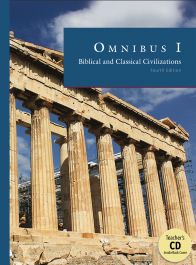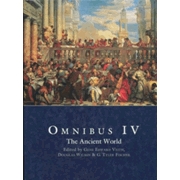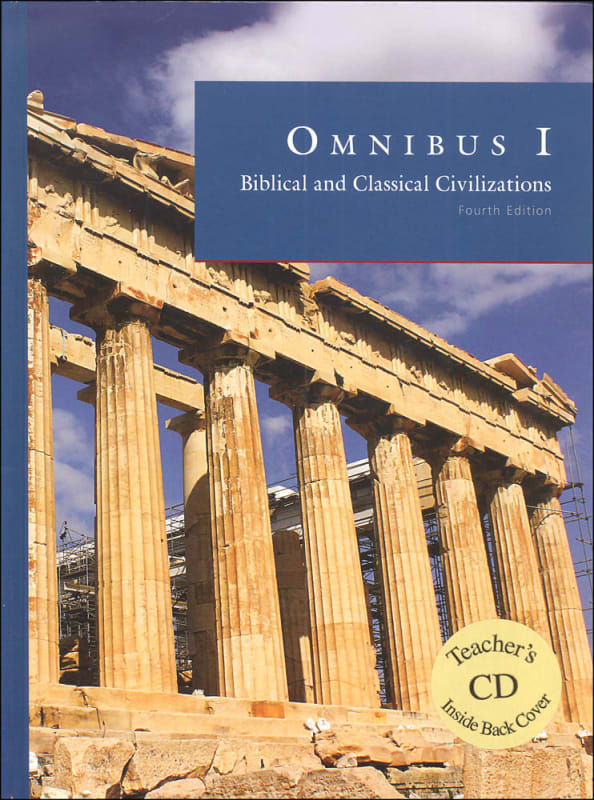Omnibus is a high-caliber academic curriculum for a Christian classical education for junior and senior high. This series of six humanities courses primarily covers history, theology, and literature, but it also touches on many other subject areas. There is a strong emphasis on personal spiritual growth and theological understanding of the faith, and how both of these should transform the student's life.
Since this program addresses significant worldview questions, the worldviews of the authors are very important. The editors explain in the preface, "The worldview we hold and from which we write is distinctly Protestant and best summarized in the Westminster Confession of Faith." They graciously go on to say, "We encourage you to become familiar with the material your students will be covering in this program in order to avoid problems where you might differ with us on these matters" (p. xi).
The courses were written to be taught in a class or group setting. A teacher with one student will suffice. While independent study is not ideal, I think a mature and highly motivated student who cannot participate in a group class and has no teacher available will still learn a great deal working through the courses on their own. (This would probably require sacrificing some valuable discussions.) While I reviewed the Omnibus textbooks, Veritas Press makes the courses available through live online courses, self-paced courses, and You-Teach kits. So while you can present these courses on your own, there's plenty of help and group classes if you want them.
The Courses
The six textbooks are titled:
Omnibus I: Biblical and Classical Civilizations
Omnibus II: Church Fathers through the Reformation
Omnibus III: Reformation to the Present
Omnibus IV: The Ancient World
Omnibus V: The Medieval World
Omnibus VI: The Modern World
Omnibus I is intended for seventh grade but is also a fitting starting place for high school students who have little to no background in classical education. The six courses repeat the historical cycle of ancient-medieval-modern history twice. The first three volumes are written with an eye to teaching logical analysis, and the last three volumes tend to stress the rhetorical skills of argumentation and debate. So there is a jump in the level of difficulty, although there is much that is the same in all of the courses.
All of the courses are designed with material for 37 weeks, and this includes reading the textbook plus many other literary works from the Great Books, Christian classics, modern fiction and non-fiction, and the Bible. The books to be read are labeled as either primary or secondary. The lesson plans would have teachers present five 70-minute sessions on a primary work each week and three sessions on a secondary work per week. A chart at the back of the book shows how much each of the selected readings is weighted toward each of the three disciplines: history, theology, and literature. This helps you keep a balance between the disciplines if you need to skip some of the readings. If students read all of the primary books, they will have the strongest weighting in the area of history. Most of the secondary readings are weighted more toward theology and literature.
Ominibus I
My review will focus primarily on Omnibus I, but the other courses are structured similarly.
The primary reading material for Omnibus I are titles from the list of Great Books. Some of those used in this course are Codes of Hammurabi & Moses, Gilgamesh, The Landmark Herodotus, The Odyssey, Early History of Rome (Livy), The Oresteia Trilogy, The Last Days of Socrates, The Twelve Caesars (Suetonius), and The Aeneid.
Examples of some of the secondary titles are Till We Have Faces; The Lion, the Witch, and the Wardrobe (and other Narnia titles); books of the Bible such as Isaiah and Jeremiah; The Unaborted Socrates; The Eagle of the Ninth; and The Holiness of God. The modern books are critical to balance and complete the ideas raised in the traditional Great Books, although students need not read every one of them.
According to the editors, "The goal or destination of this course is to learn to reason well and communicate winsomely" (p. 3). Further, "this program aims to cultivate and produce students who are culturally literate" (p.4). To that end, Omnibus I provides background and thought-provoking material for students to read and discuss before every Great Book reading assignment. Each of these sections is written by an expert on the literary work, which results in a high level of scholarship. For example, Douglas Wilson writes the sections on The Odyssey, The Aeneid, and the books from the Chronicles of Narnia, while Peter Leithart covers some of the biblical books, Ben Merkle writes on the Epic of Gilgamesh, and Jared Miller does Julius Caesar. Each of these contributions follows a similar format with information about the author of the literary work, the context in which it was written, the significance of the work, the main characters, a summary of the work, and the worldview reflected in the work.
Following this preliminary material in the text are "sessions" that lead students through both the preliminary reading and the Great Books themselves These vary in number and content depending upon the Great Book to be studied. Here's an example of how it works for the Code of Hammurabi.
Session I: Prelude begins with "Questions to Consider" that students are to work through after they have read the preliminary material. These are thought-provoking questions such as "Why are laws necessary? How do we know when laws are just?" These questions are followed by some comprehension questions and an optional activity to visit an archaeology museum for a first-hand look at Mesopotamian artifacts if possible. After this first session, students begin reading the first section of the Code of Hammurabi.
Session II: Activity puts students to work as jurists. They are given three cases with the assignment to judge them according to the Code of Hammurabi and then according to the Bible. Options are given for classroom groups or students working independently. When this is finished, students continue reading the next section of the Code. (Note that activity sessions for other lessons might involve games, projects, creative activities, debates, and more.)
Session III: Recitation has a series of comprehension questions followed by a "lateral thinking" group of questions for discussion or short essay responses. An optional activity suggests that students draw up their own legal code for their house rules. Students then read the rest of the Code.
Session IV: Discussion presents a number of questions that really are best handled via discussion. Questions such as "What do laws have to do with justice?" and "How is justice understood in our culture?" lead students through a somewhat logical progression of thought as they deal with the key ideas. An essay assignment based on responses to these questions follows.
Session V: Activity repeats the assignment of cases, with three new cases for students to judge according to the Code and the Bible.
Many lessons also have analysis and writing sessions plus optional sessions.
Evaluation questions conclude the lessons on the Code. Some questions require one- or two-sentence answers while others require one or two paragraphs. Parents will need to decide how many of the questions should be answered in writing and how many handled by discussion.
A timeline at the back of the book helps students keep the various readings in historical context. The Veritas Press Bible Cards and History Cards might be helpful aids as students work through many of the readings.
Even though Omnibus I is suggested for seventh graders, a ninth grader completing the course (including a significant number of secondary readings) should probably be awarded a unit each in history, theology, and literature. Since there are so many possible writing assignments, including lengthy essays, this course might also meet the composition/grammar requirement depending on how those assignments are handled.
Illustrations of classical art, architecture, and sculpture throughout the text might prompt you to expand into coverage of art appreciation. The editors suggest two reference books that should be helpful resources through the entire curricula: Western Civilization by Jackson Spielvogel (Wadsworth/Thomson Learning) and History of Art for Young People by H.W. Janson and Anthony F. Janson (Harry N. Abrams, Inc.). The latter book will provide more than enough material to create an art appreciation course.
Omnibus IV, V, and VI
As I mentioned earlier, the last three volumes in this series are written for the rhetoric level rather than the logic level. While much remains the same as in the first three volumes, the latter three add a number of different types of sessions and "discipline essays." The goal is to help students broaden their thinking and develop their rhetorical skills so they are prepared to discuss a wide range of topics with people.
In addition to the types of sessions in the first three volumes—prelude, discussion, activity, recitation, analysis, writing, and review and evaluation—the last three volumes have sessions for student-led discussions, current events, poetry, aesthetics, and trials (verbal arguments and debate). There are also opportunities for students to present speeches.
Students have more writing assignments, but they tend to be briefer than those in the first three volumes. Essay assignments range across disciplines such as culture, theology, and art. For example, an essay question following Romeo and Juliet in Omnibus V asks, "How should love change people?"
The Teacher's CD-ROM
The CD that comes packaged in the back of each textbook contains the complete textbook as PDF files. Answers to questions and notes for discussions are included in the PDFs. In addition, the CD has other extras for the teacher: lesson plans, optional midterm and final exams for each semester, answer keys, a map of Narnia and a Narnian game board (pages to print out and assemble), an extra short story, and the grading file described below. The answers provided on the CD will likely be the crucial factor in making this course practical for most parents to teach. Nevertheless, most of the discussions will require some familiarity with the readings themselves.
The CD has a PDF file explaining how to calculate grades for each subject area in relation to each reading and its assignments. It really is quite complex, so the publisher has made it easier by adding an Excel file that will automatically perform the calculations for you for each student. While it isn't absolutely necessary that you use the Excel file, I expect that it will be extremely helpful.
Summary
The price might seem high at first glance, but these are beautiful, hardcover, full-color textbooks (with from about 500 to 700 pages each) that might cover all subject areas except math, science, and foreign language. The courses are worked out in such thorough detail that I really believe it will be possible for parents without a classical background to teach them well if they read the material and participate in discussions with their teens. Parents who do so will be acquiring an excellent education for themselves in the process. Parents who do not want to teach have other course options available through Veritas Press.













